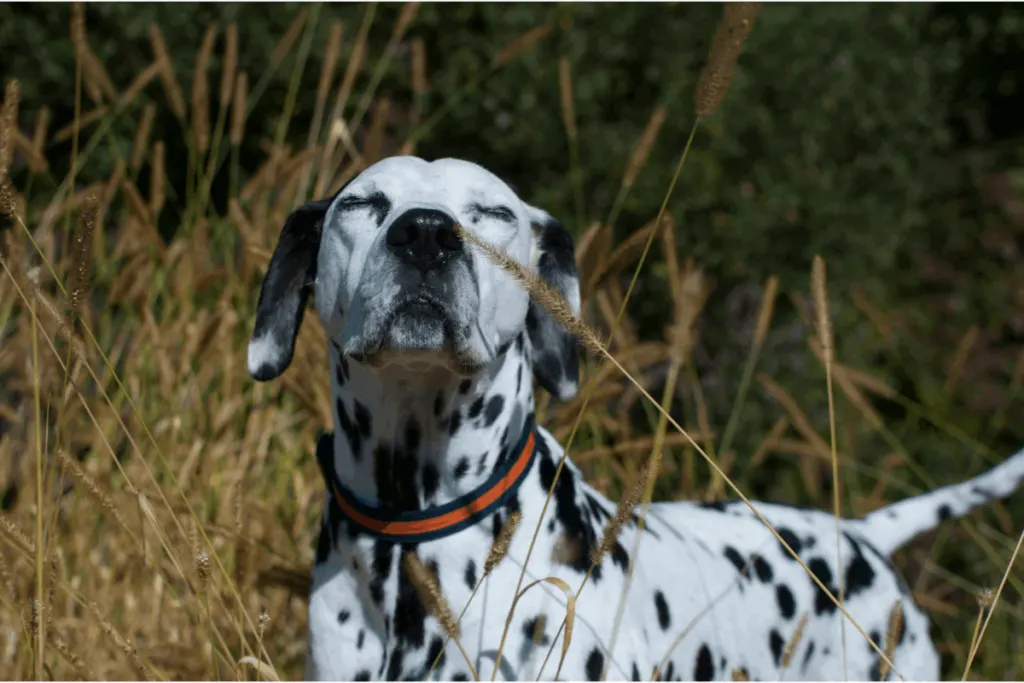
You always hear and read about foods and other substances that are toxic to dogs when they eat them, but certain smells can be just as toxic to our canine friends.
Therefore, is important to know what these scents are so that we can help our dogs to avoid them.
Scents can be toxic to dogs because they are emitted by hazardous substances, which can be inhaled. Scents that are toxic to dogs include chemical cleaners, paints, perfumes, pesticides, and smoke fumes. Scents that are potentially toxic to dogs include various essential oils such as citrus and nutmeg.
Some toxic scents are more obvious than others, and we will go through both the obvious and the less obvious kinds in this article.
But first, let’s look at how a scent can be toxic.
Click Here to Jump to a Section
How Can a Scent Be Toxic?
It sounds strange to say that a smell can be toxic, and that’s because, technically, it can’t be.
Smell is a concept. It is the brain’s interpretation of a physical stimulus to the olfactory sensors.
So, when we talk about scents being toxic, we are actually referring to the substance (the physical matter) that made contact with the olfactory sensors in order to trigger a neurological interpretation of the stimulus.
Some scents are emitted by solid particles in the air, some are from liquid droplets, and others are produced by gases. But all involve matter.
Whether it’s solid, liquid, or gas, the fact that it is in contact with the dog’s respiratory passages means that it has the potential to do harm.
Inhalation as a Route of Exposure
When exposure to toxic substances is an issue, inhalation is one of the main three routes examined.
The other two are dermal exposure (skin contact) and ingestion exposure (eating or drinking).
Possible Effects of Inhalation Exposure
When a scent is inhaled, it has the potential to cause mechanical irritation of the respiratory passages.
Alternatively, it can cause physical damage through chemical processes—think about corrosion caused by toxic vapors.
Then there is also the possibility that the solid, liquid, or gas that is emitting the scent will be absorbed by the mucous membranes of the respiratory system and enter the bloodstream.
From here, it can do all kinds of damage.
Chemicals That Are Toxic for Dogs to Inhale

The term “chemical” is very broad, and not all chemicals are bad; some are so natural that even our own bodies (or our dogs’ bodies) produce them.
Here, however, we are talking about the chemicals that are not natural and harmless.
Chemical Cleaner Scents Can Be Toxic to Dogs
Chemical cleaners release noxious vapors, which, when inhaled, can be toxic to your dog.
Now, this doesn’t mean you should stop cleaning your house! What it means is that you have to be careful how and where you store and use these products.
For example, you should never leave cleaning bottles out in the open where they can get knocked over.
Beyond the drinking and skin contact hazards of this, the fumes can build up in a closed room or house and reach levels that are toxic for your dog as they breathe them in.
Additionally, it’s a good practice to properly ventilate a room once you have cleaned it so that the vapors can dissipate quickly.
Paint Scents Can Be Toxic to Dogs
The chemicals used in house paint, art paint, nail polish, etc., can be toxic to dogs when inhaled.
So, if you paint a room, make sure that it is well-aired out before allowing your dog to spend any significant time in that room.
Additionally, art studios, nail salons, and the like are not appropriate areas for dogs to spend a lot of time, especially if ventilation is poor.
Perfume Fragrances Can Be Toxic to Dogs
The scent of your perfume or cologne can be toxic to your dog because of the chemicals included in the fragrances.
Once again, it’s not the actual scent that causes toxicity; it is the solid, liquid, or gas carrying the scent.
So, in this case, the smell of the perfume or cologne is an indication that your dog may be inhaling chemicals like acetone, linalool, phthalates, etc.
Pesticide Scents Can Be Toxic to Dogs
Now, you already know that pesticides are harmful and need to be treated with care. They are a danger to dogs (and humans) via all three routes of exposure: ingestion, dermal contact, and inhalation.
Arguably, the biggest risk is the inhalation of these vapors because you can more easily make sure that your dog does not eat, drink, or touch the pesticides.
If you think about naphthalene, which is the primary ingredient in mothballs, you can put them high up so that your dog does not have access to them.
However, they are still releasing odors into the air, and these can build up, especially in poorly ventilated areas like basements, attics, or closets.
Scents Associate With Burning Can Be Toxic to Dogs
When you burn something, chemicals are released into the air which your dog can smell (inhale).
There are many different chemicals in smoke and much of it depends on what is burning.
It is important to note that many by-products of burning which can be inhaled by your dog are carcinogenic, including the gases released from paraffin candles.
Using an Air Purifier
Regardless of the cause of a scent that may potentially harm your dog, the use of a good air purifier can aid in reducing the risk.
If you are looking for the right type of air purifier to reduce the potentially harmful impact of scents around the home, then you will want to choose a filter that uses True HEPA and Activated Carbon Filter technologies.
An example of an effective air purifier using True HEPA and Activated Carbon Filter technology is this Levoit Air Purifier. It’s one of the most popular models on Amazon because of its reasonable price point combined with it’s small size and variety of available filters.
The ability to customize this purifier to your specific needs is makes this one a standout amongst the rest. For example, if you have a pet you can use the Pet Allergy filter, but if smoke is an issue, you can use the Toxin Absorber Filter.
There are a number of effective purifiers on the market – the Levoit is just one of them. Whichever one you choose, just make sure to do your research and confirm that it uses the same effective filtering technologies.
Essential Oil Scents That Are Potentially Toxic to Dogs
Unless you’ve been living off the grid for the last few years, you will have noticed a significant increase in the popularity of essential oils.
This essential oil boom, as it were, is likely the reason why people have started wondering what scents can be toxic to dogs.
People love their diffusers, but they love their dogs even more, and generally want to be responsible pet parents.
A Lack of Research Requires Logic and Extrapolation
There is hardly any official research on essential oil toxicity in humans, let alone dogs, so we have to think logically and extrapolate data to build our list of potentially harmful essential oil scents.
What do we mean by extrapolate?
Well, we mean that we have followed a line of reasoning from plants being dangerous for dogs to eat to the oils of those plants being dangerous for dogs to inhale. The logic is as follows:
- Certain plants contain constituents that irritate the mucous membranes lining the digestive tract or are absorbed into the bloodstream from the digestive tract. In these two ways, these plants cause toxicity.
- Essential oils are concentrated extracts of plant constituents, so the plants still pose a toxicity threat when in oil form (likely an increased threat).
- The respiratory tract is also lined with mucous membranes, which can become irritated, and substances can also be absorbed into the bloodstream from the respiratory tract.
- Thus, inhalation of essential oils extracted from plants that are toxic for dogs to eat are also potentially harmful for dogs to inhale.
As there is no scientific proof, it means that the scents that we list here are not guaranteed to be toxic to dogs, but there is a definite chance that they could be, so why take the risk?
List of Potentially Toxic Essential Oil Scents
This list is based primarily on the FDA’s list of plants that are toxic for dogs to eat, as well as VCA Hospital’s list of essential oils that are dangerous to dogs via ingestion and dermal contact.
The list also applies to potpourri, scented candles, and wax melts because they most commonly use essential oils to imbue the potpourri and wax with scent.
- Almond
- Aloe vera
- Cinnamon
- Citrus (grapefruit, lemon, orange, etc.)
- Chrysanthemum
- Clove
- Cyclamen
- Hemerocallis (daylily)
- Hibiscus
- Hyacinth
- Hydrangea
- Lily
- Mountain laurel
- Narcissus
- Nutmeg
- Oleander
- Pennyroyal
- Peppermint
- Philodendron
- Pine
- Rhododendron
- Schefflera
- Sweet birch
- Tea tree
- Tulip
- Wintergreen
- Ylang ylang
How Much Essential Oil Needs to Be Inhaled to Become Toxic?
The amount of each essential oil scent that is required to produce toxicity is something that would need to be determined scientifically for each different essential oil.
If you are adamant about using essential oils around your home, there are steps that you need to follow in order to make sure your dog stays safe. Take a look at the informative article below for some important guidelines:
Is Aromatherapy Bad for Dogs? How to Safely Use It
For an even more in-depth look at using essential oils around your dog, be sure to watch this really informative video by Dr. Andrew Jones, DVM. It will walk you through the basics, and even shows how to make some useful remedies at home!
Final Thoughts
Ultimately, a scent itself is not toxic to a dog because it is just the brain’s interpretation of a physical stimulus.
However, the particles emitting the scent can be toxic to dogs when inhaled.
This means that if your canine friend can smell chemical cleaners, paints, perfumes, pesticides, or smoke fumes then they are at risk of inhalation exposure to the constituents of these chemicals.
Furthermore, certain essential oil scents are potentially toxic to dogs, but more research is required to confirm this.
For now, however, it is not worth risking exposing your dog to these scents.
